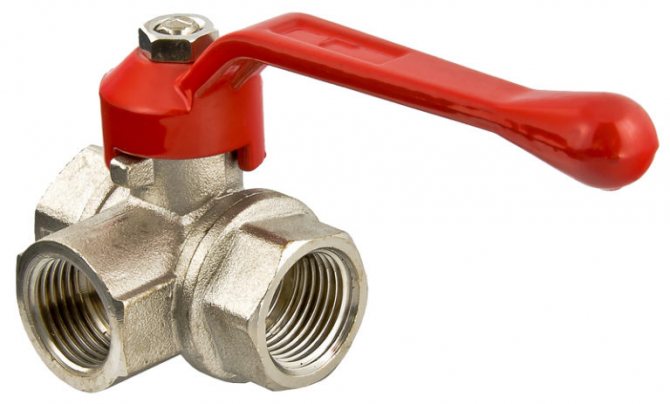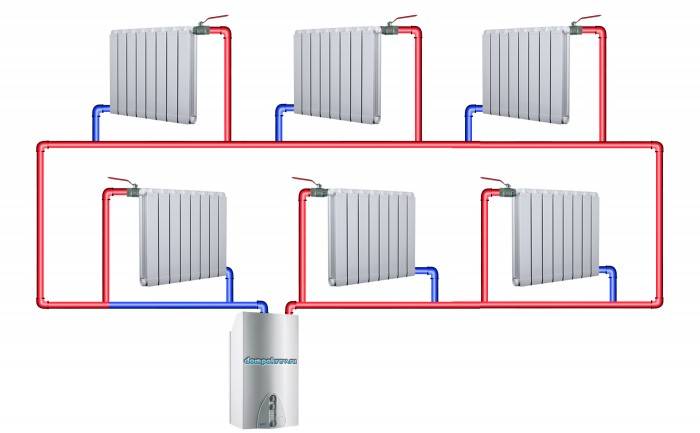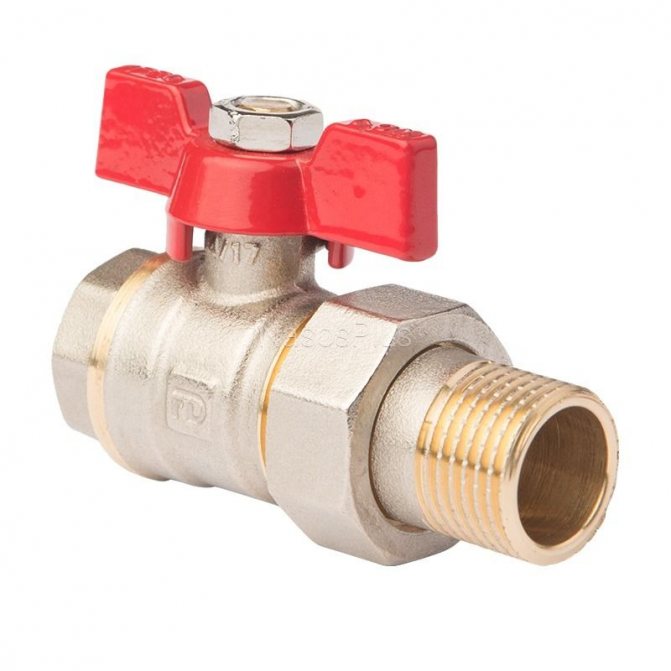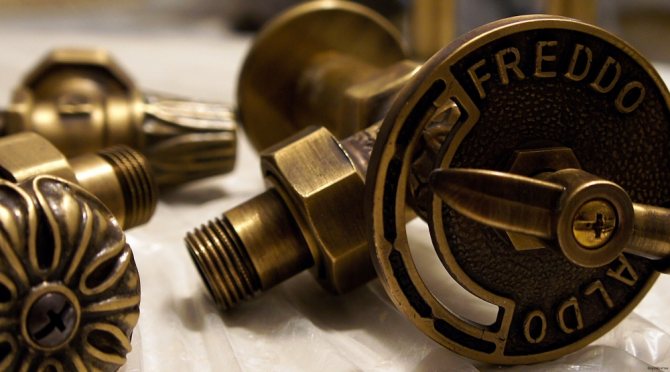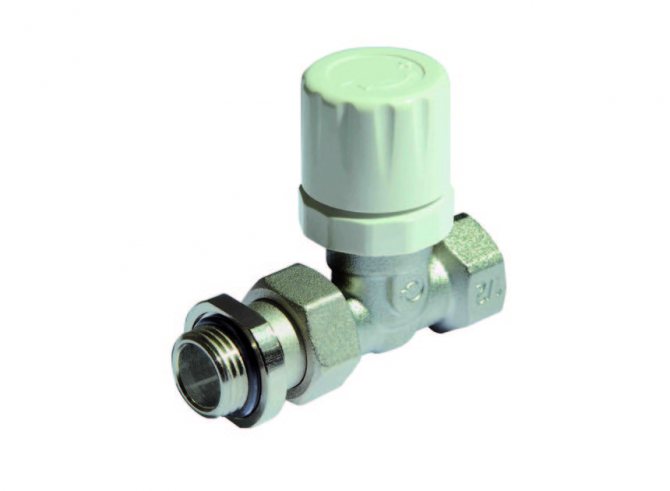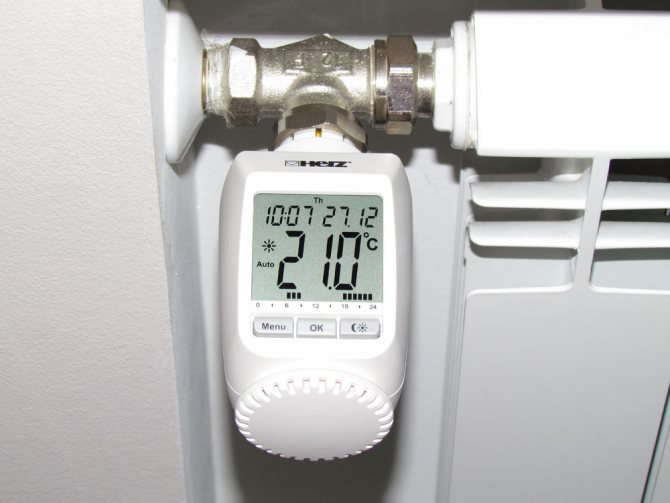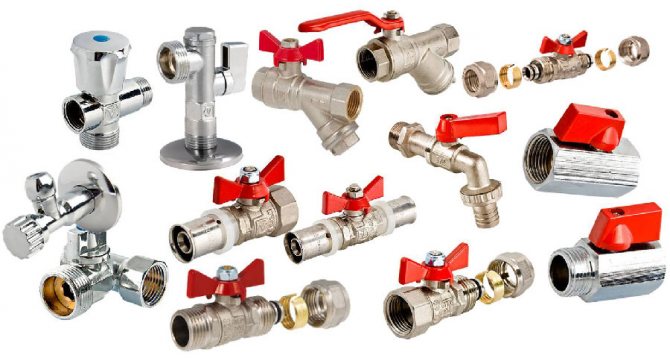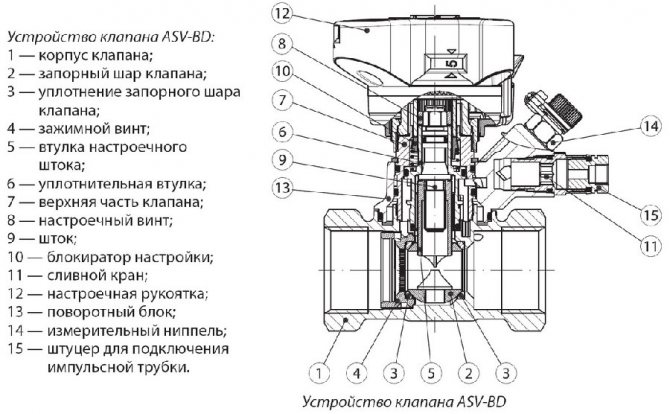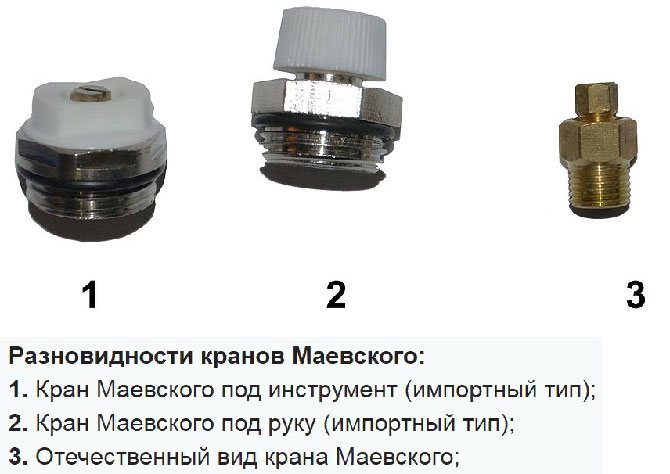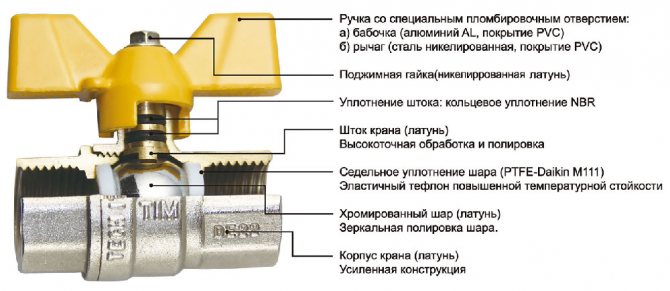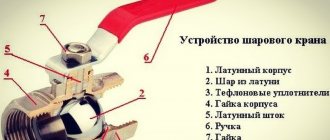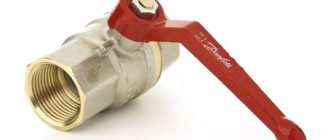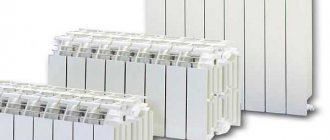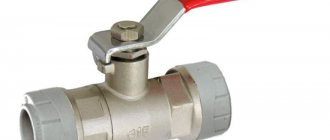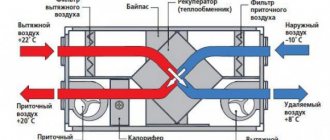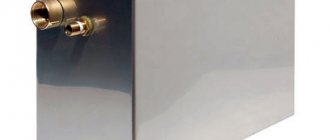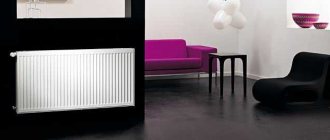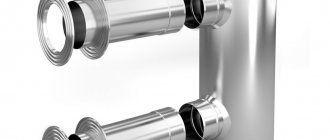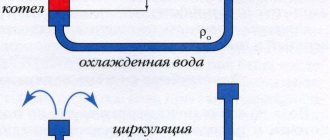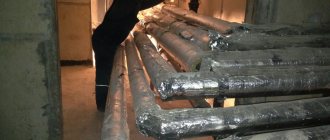Ball valve
This is the most famous type of valves. Inside it there is a smooth ball that has a through hole and is able to rotate 90 ° C, thus, regulating the flow of water in the pipe, blocking or opening it. The design of the mechanism provides it with minimal resistance to flow in the open state. It is designed to operate in a fully open or fully closed position to quickly shut off or drain water in some cases. Intermediate provisions are possible but prohibited.
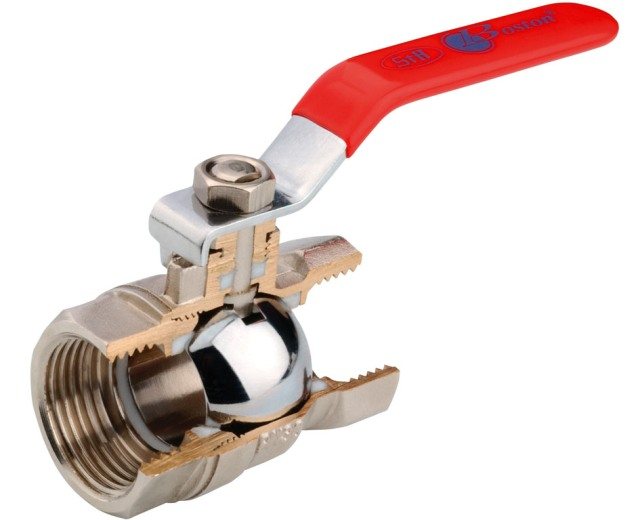
The materials for these mechanisms will be nickel-plated brass and stainless steel, and polymer materials are also used for metal-plastic systems. There are expensive and high-quality Danfoss, Giacomini, Bugatti cranes on the market. For limited financial opportunities, Chinese and Turkish Valtec, Fado are offered. Good quality at a low price is offered by the Chinese AGUA-WORID.
The most common type of faucet is a valve. Allows you to adjust the pressure. The channel for the flow inside it is perpendicular to the fluid flow in the supply pipes. Installation must be carried out with careful consideration of the markings so that the water flows in only one direction.
There are valves with conical valves for heating systems. They are most effective for these conditions. Fully open, it allows the maximum amount of liquid to pass through, which makes the heat transfer of the battery more efficient. The mechanism allows you to reduce the flow of the coolant and reduce heat transfer if the room is too hot and, thus, control the temperature.
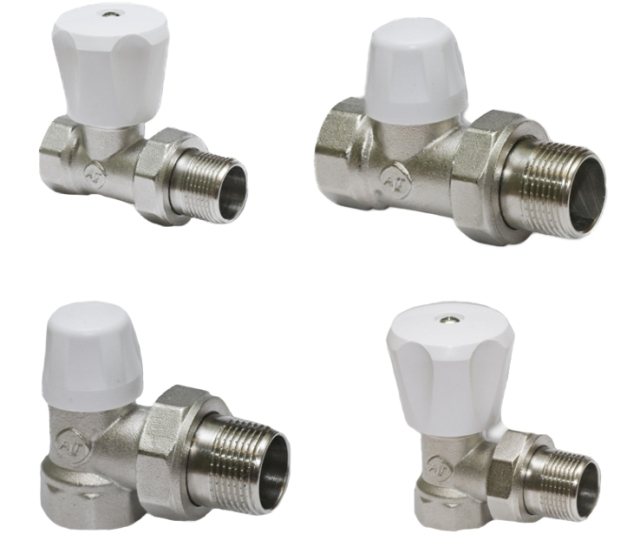

There are such types of them:
- adjusting (straight and angular). They have manual control. They are used in autonomous heating. They cannot accurately adjust the heat transfer due to the lack of a scale and a temperature sensor;
- equipped with a thermal head. Their design allows blocking or limiting the temperature rise through manual or automatic control. Installed on two- and one-pipe systems. Adjustment is simple - the required temperature is set manually using a limit ring;
- with thermostat. Installed in front of the battery. The flow of the coolant is controlled by a valve mounted in front of the thermostat.
There are no plastic valve taps, they are made of brass, steel or a combination of these materials.
Shut-off valves
This type of fittings reduces / stops the supply of coolant at a certain place in pipelines or radiators. This is done compulsorily.
As a rule, it is presented in the form of taps, sliding elements with various design features. When choosing a model of valves for heating systems, one should take into account the installation method and the material from which it is made.
A quality element must withstand the peak temperatures that the system can produce and the maximum pressure level. This information is recorded by the manufacturer in the operating instructions or on the valve body.
Shut-off valves are one of the most important components of a heating system. Installation is carried out along the entire perimeter in places where it may be necessary to limit the flow of the coolant.
Almost all factories that produce these products provide a wide range of models for choosing the right one. There are special parameters that you should pay attention to when buying.
- For connection to the mains, the shut-off valves are equipped with branch pipes. The diameter of which plays a significant role. The device should not cause any restrictions on the flow and volume of water in the open state.
- Accuracy depends on the level of adjustment. Ball valves can be used to quickly stop the coolant flows, and wedge-shaped valves allow you to gradually adjust the volume of the supplied fluid.
- The possibility of installing an automatic regulating element for opening the crane is also taken into account when choosing products.
It is important not only to understand how to properly carry out the installation, but also to take into account the performance of the valve, to know its structure. Independent attempts to install valves without special skills and knowledge can lead to many problems. For example, an incorrectly installed fittings will let the coolant pass through itself or air. The pressure will be low and the flow rate will increase. Not to mention leaks and other malfunctions.
Types of heating valves
The use of such elements is easily explained by the design features and the range on the market. Shut-off valves are expressed in two types of valves:
- ball;
- stock.
The first equipped with a ball that has a hole. When the handle is turned, the diameter is adjusted internally. Thus, the force of the fluid flow in the pipeline system is regulated. This element is characterized by simplicity in blocking the flow.
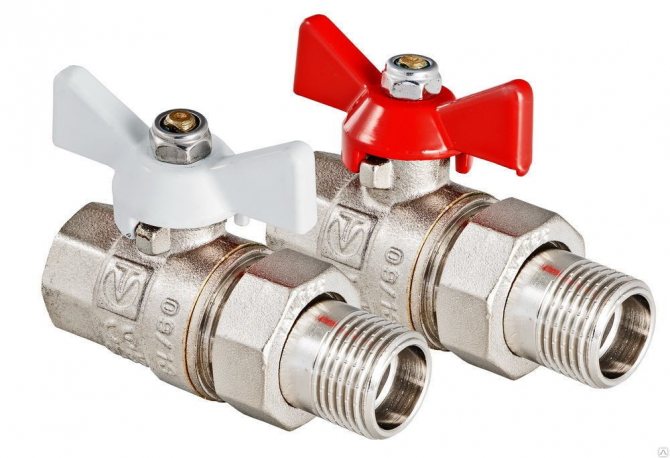

Example of a ball valve with a detachable connection
Rod, or valves, are used to close the stem equipped with a rubber or ceramic gasket. To stop / restore the water supply, you have to make several turns of the handle. This element can be used as a tool for more accurate flow force adjustment.
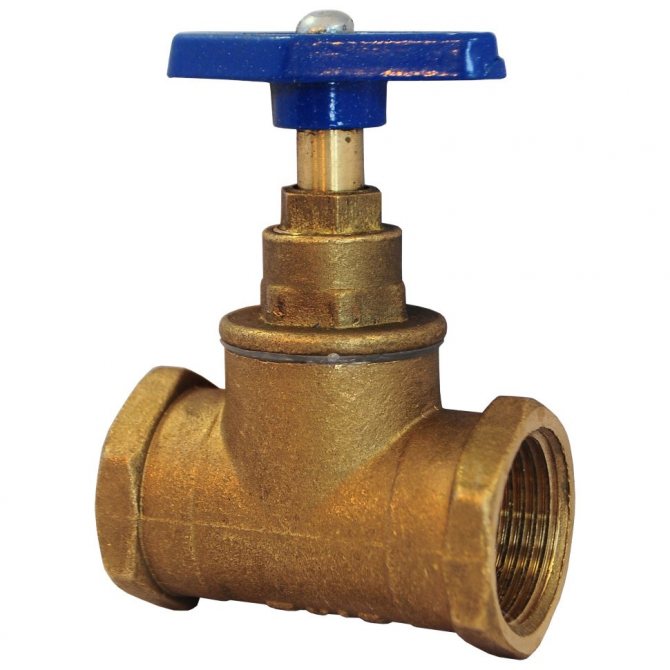

Shut-off valve
Installation and selection of fittings is carried out taking into account the operational parameters of the heating system. Otherwise, it will not be easy to achieve the necessary functionality and tasks set for the reinforcement.
Heating valves
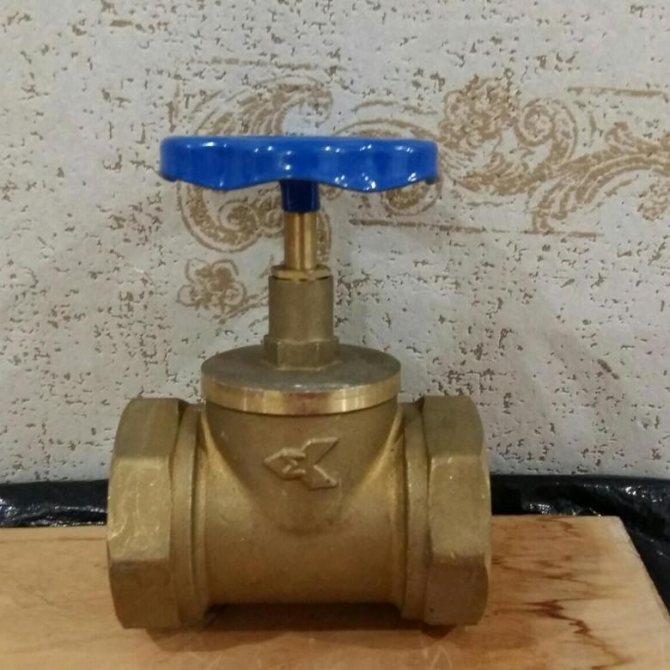

Outwardly they resemble valves, but differ in larger sizes. Also, the internal channels have a different appearance. Due to the wave structure inside, such elements provide exceptional protection against significant pressure drops. Gate valves allow you to keep the stem intact and ensure the sealing of the valve. Their installation is carried out on areas of the pipeline, the diameter of which is greater than 100 mm.
Selection and installation of radiator valves
Connecting heating devices using correctly selected shut-off and control valves improves the functionality of the heating system and makes operation more convenient. The faucet for the heating radiator must be made of quality materials and properly installed.
Fittings for heating radiators are divided into shut-off (blocking the flow of the coolant) and regulating (designed to control the flow rate). The valves are only shut-off valves, the control valves are valves and gates. But in everyday life, taps mean all types of shut-off and control valves.
Ball valve
This is the most famous type of valves. Inside it there is a smooth ball that has a through hole and is able to rotate 90 ° C, thus, regulating the flow of water in the pipe, blocking or opening it. The design of the mechanism provides it with minimal resistance to flow in the open state. It is designed to operate in a fully open or fully closed position to quickly shut off or drain water in some cases. Intermediate provisions are possible but prohibited.
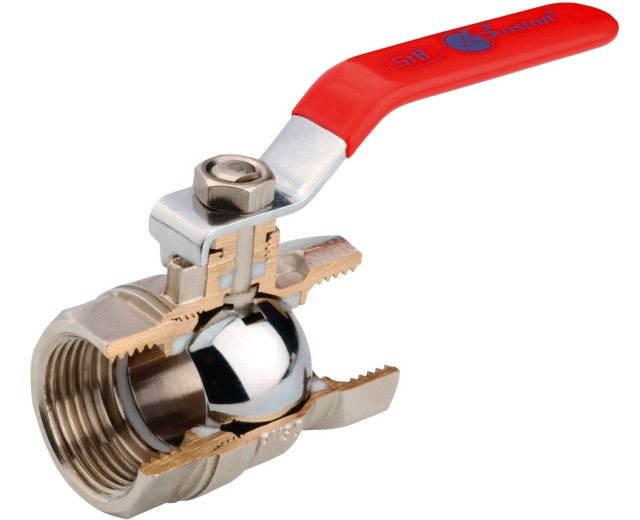

The materials for these mechanisms will be nickel-plated brass and stainless steel, and polymer materials are also used for metal-plastic systems. There are expensive and high-quality Danfoss, Giacomini, Bugatti cranes on the market. For limited financial opportunities, Chinese and Turkish Valtec, Fado are offered. Good quality at a low price is offered by the Chinese AGUA-WORID.
The most common type of faucet is a valve. Allows you to adjust the pressure. The channel for the flow inside it is perpendicular to the fluid flow in the supply pipes. Installation must be carried out with careful consideration of the markings so that the water flows in only one direction.
There are valves with conical valves for heating systems. They are most effective for these conditions. Fully open, it allows the maximum amount of liquid to pass through, which makes the heat transfer of the battery more efficient. The mechanism allows you to reduce the flow of the coolant and reduce heat transfer if the room is too hot and, thus, control the temperature.
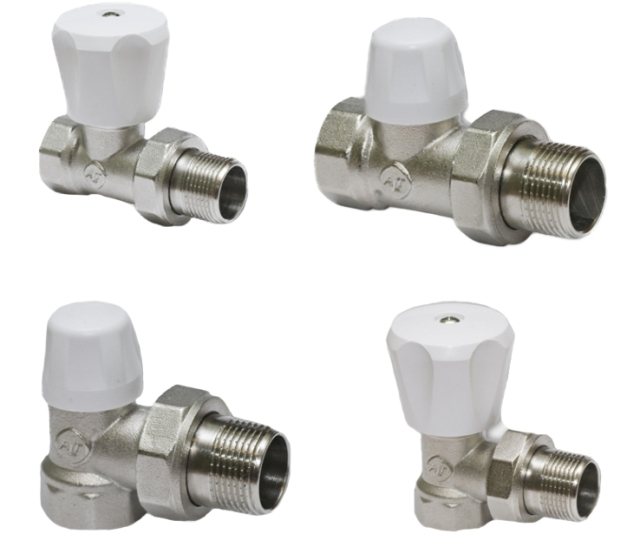

There are such types of them:
- adjusting (straight and angular). They have manual control. They are used in autonomous heating. They cannot accurately adjust the heat transfer due to the lack of a scale and a temperature sensor;
- equipped with a thermal head. Their design allows blocking or limiting the temperature rise through manual or automatic control. Installed on two- and one-pipe systems. Adjustment is simple - the required temperature is set manually using a limit ring;
- with thermostat. Installed in front of the battery. The flow of the coolant is controlled by a valve mounted in front of the thermostat.
There are no plastic valve taps, they are made of brass, steel or a combination of these materials.
Types
Shut-off valves for heating make the efficient operation of all equipment included in the system, saving energy and material resources to a significant extent. It is installed between radiators or pipes and is of several types:
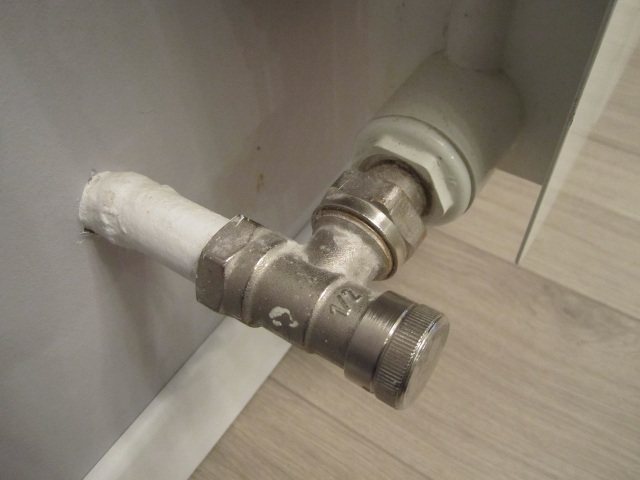

- ball valves with various threads;
- shut-off valves;
- rotary locks;
- flanges and fittings;
- check valves;
- gate valves.
Ball valves
For the convenience of connecting radiators of the heating system, ball valves made of brass are chosen. A similar locking and regulating design is available with an internal thread, a union nut, an air vent and a plug. The last two are used in cases when it is necessary to remove air from the system or, conversely, run into it. Ball valves are also used when installing a pressure gauge.
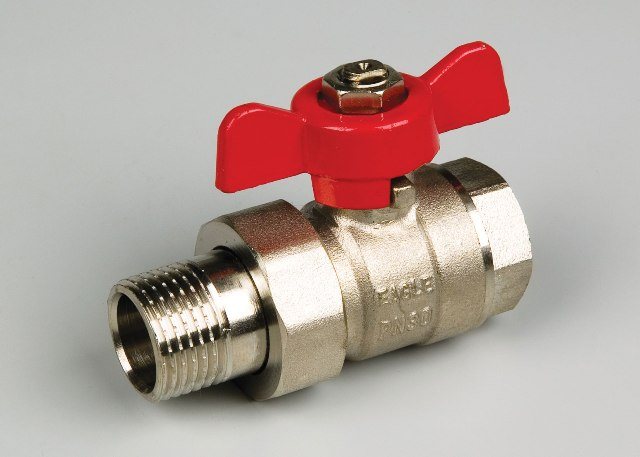

Such devices are equipped with full bore balls. Each of them has a special system that protects the body from damage when water freezes and prevents the spread of bacteria that appear as a result of liquid stagnation in the pipeline.
Most ball valve models have O-rings that make contact with each other, not with the body surface. This increases the wear resistance of the entire crane. A valve of this type contains important information on the body regarding its installation.
Shut-off valves
To connect or disconnect a separate radiator (for the purpose of its dismantling or prevention), shut-off valves are used in the heating system without emptying it. They are of two types: straight and angular. Such devices are made of nickel-plated brass.
Some models are equipped with a drain cock (also made of brass), with its help, remove water from the radiator or fill it with liquid.
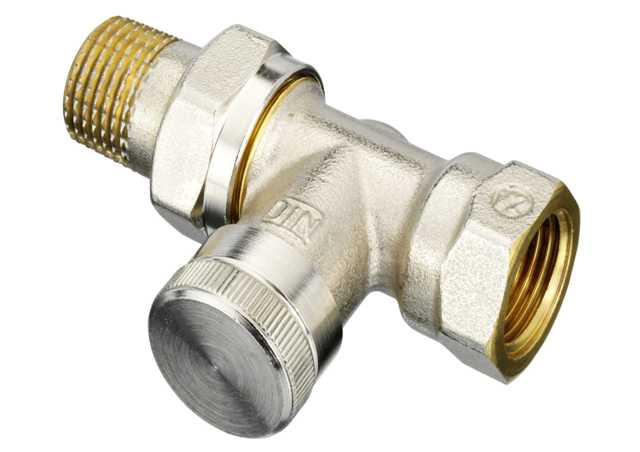

The hose nozzle of this design can be rotated to either side.
Restrictions in the field of application: in order to avoid the accumulation of lime deposits and corrosion, the valves are recommended to be used in heating systems with a coolant that meets the requirements of the "Rules for the technical operation of power plants and networks of the Russian Federation".
Rotary gates
These are shut-off and control valves made in the form of a disc. The element rotates around an axis located perpendicular or at an angle to the direction of movement of the coolant. Butterfly valves are used not only in heating systems, but also for water supply.
Check valves
Such devices are used to protect the system from unforeseen loads, regulate the flow of the coolant in the pipeline. They can be mounted in different places. The brass socket valves are threaded and have a gasket on the inlet side. The whole structure runs on a spring that holds the stem. It, in turn, is recessed at a certain pressure, thereby giving a passage to the coolant. Such equipment serves for a long time and is inexpensive.
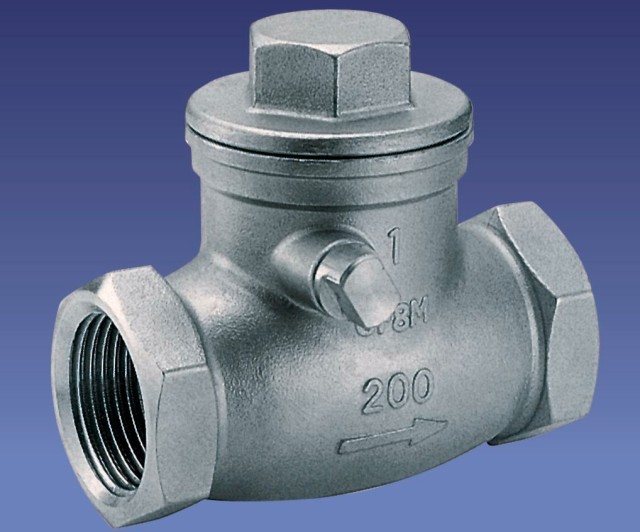

To connect the heating system, use check valves made of brass, with a stainless steel spring and a plastic stem. Install them in the circuit after the circulation pump. The maximum allowable temperature for such mechanisms is 120 ° C.
Also, such elements can be installed on high pressure tanks.
Flanges
These connecting parts are used to connect fittings to pipes, connect individual parts of the pipeline, and install additional equipment. They are produced in the form of a disc or ring with holes. In shape, they are flat or collar (with a ledge, depression, thorn, groove).
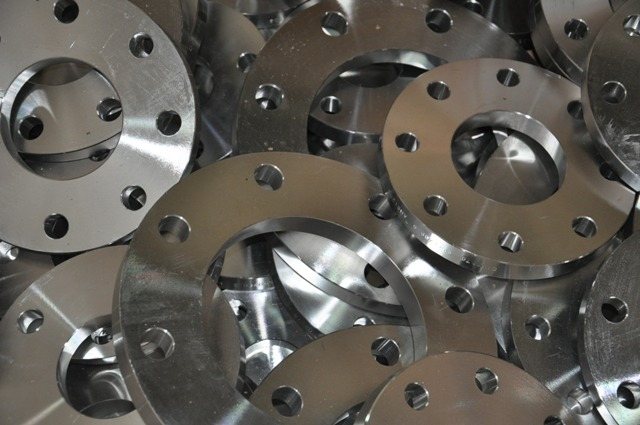

Made of steel. They are distinguished by durability, wide temperature range, excellent anti-corrosion properties.
Fitting
Fittings are connecting elements for the heating system piping. These include:
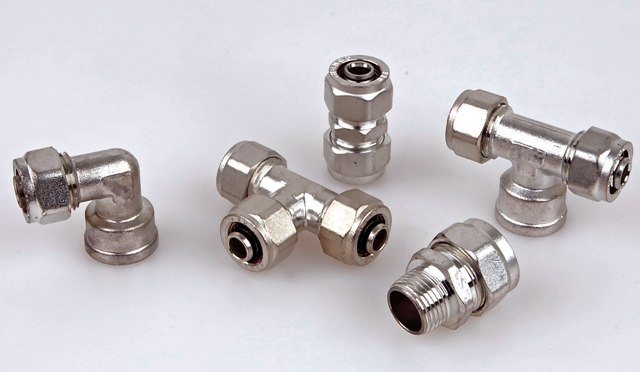

- couplings (do not change the direction of the pipeline, have different diameters of the outlets);
- squares (change direction by 45-90 °);
- tees (designs with 3 outlets for combining pipes of different diameters at different angles);
- crosses (for 4 pipes perpendicular to each other or located at a certain angle);
- plugs (put on the end of the pipe).
Gate valves
The design of this part includes a metal body, a control lever, a butterfly valve. Such a mechanism is equipped with a locking element located perpendicular to the flow of the coolant. The regulating function of this element is not provided. It works in 2 positions: "open" or "closed".
The cross-section of the valves almost coincides with the diameter of the pipes. Such elements are distinguished by simplicity of design, low level of hydraulic resistance. It is especially advantageous to use them in main pipelines.
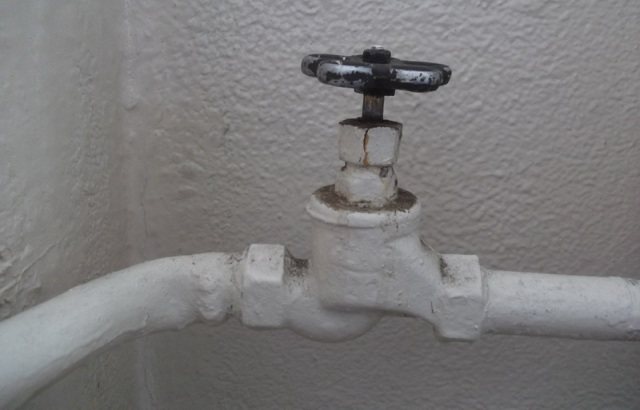

Today, more and more often they choose plastic and metal-plastic pipes for heating systems, respectively, they use polypropylene fittings for heating radiators. It is placed on each element of the system separately.
Types of heating systems and the principle of regulating radiators
Valve handle
In order to properly adjust the temperature of the radiators, you need to know the general arrangement of the heating system and the layout of the coolant pipes.
In the case of individual heating, regulation is easier when:
- The system is powered by a powerful boiler.
- Each battery is equipped with a three-way tap.
- Forced pumping of the coolant was installed.
At the stage of installation work of individual heating, it is necessary to take into account the minimum number of bends in the system. This is necessary in order to reduce heat loss and not reduce the pressure of the coolant supplied to the radiators.
For uniform heating and rational use of heat, a valve is mounted on each battery. With it, you can reduce the water supply or disconnect it from the general heating system in an unused room.
- It is impossible to adjust the radiators in the central heating system of multi-storey buildings equipped with the supply of the coolant through the pipeline from top to bottom. In this situation, the upper floors open the windows due to the heat, and it is cold in the rooms of the lower floors, since the batteries are barely warm there.
- Better one-pipe network. Here, the coolant is supplied to each battery with its subsequent return to the central riser. Therefore, there is no noticeable temperature difference in the apartments of the upper and lower floors of these houses. In this case, the supply pipe of each radiator is equipped with a control valve.
- A two-pipe system, where two risers are mounted, provides a coolant supply to the heating radiator and vice versa. To increase or decrease the coolant flow, each battery is equipped with a separate valve with a manual or automatic thermostat.
Shut-off and control valves
A type of pipeline fittings for heating systems is used to adjust the parameters of the working environment. Different types of control are used depending on the situation. But the principle of operation always consists in changing the flow rate of the passable coolant, overlap or volume distribution.
Three-way valve
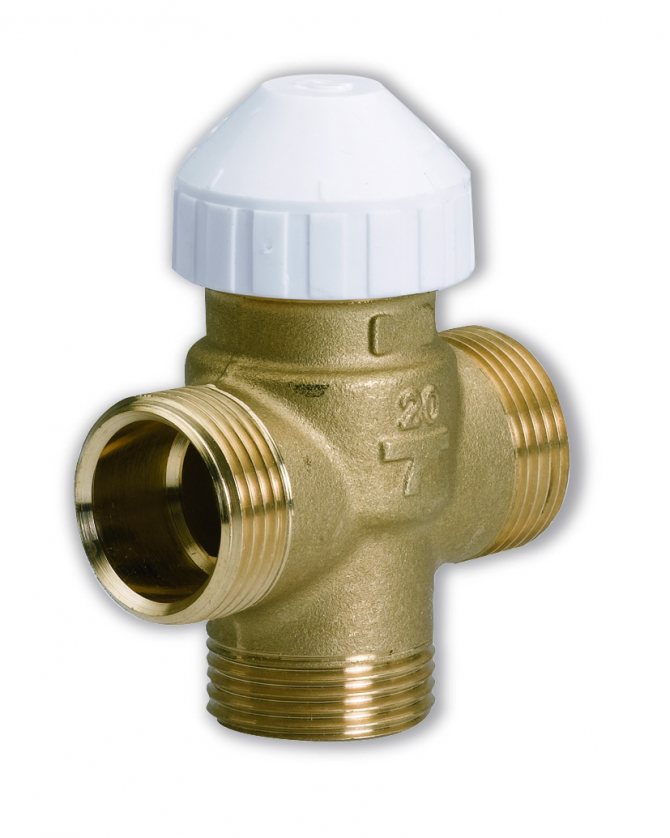

One of the types, which works by regulating the flow of the coolant in heating systems. Its main task is to change direction, mix or split the work flow required in certain situations. Equipped with three custom holes. The work is based on the penetration of the working flow and the direction adjustment with a special shutter installed inside the product.
Balancing valve
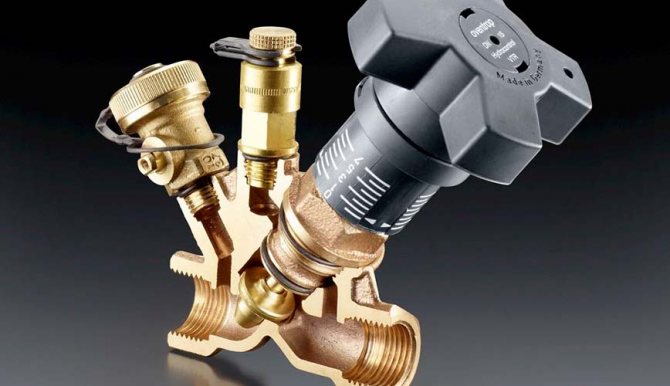

Serves to adjust the cross-section for the passage of the heat-transfer fluid in a given amount. The expense will not be constant. Its level depends on the difference in pressure drop. The balancing valve is called because of the quantitative relationship between the two parameters of the flow rate of the liquid intended for heating the room. As a rule, it is not used in heating systems in which a low flow rate of the heating medium. It is mainly used when it makes sense to create resistance on the contours to equalize flows. Allows you to get a regular uniform flow rate of the coolant, not depending on the differences in the power of the pumping units. In other words, it eliminates the possibility of excess pressure drops.
Mixing module
Serves to expand the heating system. Enables correct control of the heating circuit pump. Expands the use of automation and control of direct circuits, circuits with mixing, buffer energy storage.
In order to equip the heating system in the correct way, you should familiarize yourself with the functionality of the heating fittings and understand its general task - to adjust the flow of the liquid heat carrier to eliminate the flow rate and control the comfortable temperature regime. With the help of these simple and convenient components, the user will be able to customize the heating system in the way that suits him. Each presented type is responsible for certain functions, which cannot be dispensed with.
Types of materials used
When deciding which tap to put on a heating radiator, you should pay attention to the material of its manufacture. First of all, the main requirement for the material is its anti-corrosion properties.
Synthetic brass is most often used for production, and products made of high-quality polypropylene are also popular. The top layer can be additionally protected by metal spraying.
The types of fasteners differ depending on the material. So, a brass faucet is attached using a fitting or thread to pipes made of plastic or metal. To install a polypropylene valve, you will need to select a welding method.
Useful information for those looking to choose a universal locking device
Battery valve
Choosing a tap for a radiator
it is important to pay attention to the material from which it is made. The locking device works in the most aggressive environment. It is constantly in water, exposed to high temperatures and water shocks
Therefore, it is important that the material can withstand all these negative factors.
It is constantly in water, exposed to high temperatures and water shocks
Therefore, it is important that the material can withstand all these negative factors.
Most often, faucets for radiators are made of alloys. Most of the models are made of brass. It is a very durable metal that is not afraid of corrosion. But for even greater strength, the brass is coated on top with a protective metal compound. This is the best option for heating applications.
Sometimes, instead of brass taps, sellers can slip a fake of them - silumin control valves, which outwardly, like two drops of water, are similar to the original models.
After a year of operation, breakdowns often occur that can lead to utility breakdowns. After all, from the inside, the silumin rusts very quickly, and corrosion instantly corrodes the body, making its walls very thin. Therefore, any water hammer easily ruptures the locking device. Even if this does not happen, there are often cases when, by simply opening or closing the tap, it simply remains in the hands of a person, falling off the base. If there is hot water inside the battery at this time, burns will certainly occur. So beware of counterfeiting!
So, the tap for the heating battery must necessarily be made of brass - only this alloy easily tolerates high temperatures and hydraulic shocks. It is better to choose ball locking mechanisms that have high warranty periods and demonstrate increased tightness. Such a crane can be installed both horizontally and vertically.
Functional purpose
Why equip a radiator with taps? Their installation when connecting heating devices makes it possible
:
- completely turn off the radiators if, for some reason, the room does not need to be temporarily heated;
- shut off the coolant supply for flushing or revising individual radiators without draining the coolant from the entire system;
- regulate the intensity of heat transfer from the batteries in manual or automatic mode, maintaining a comfortable temperature regime in the room;
- remove air pockets from radiators, increasing system efficiency and reducing the risk of metal corrosion.
Types of control valves
Existing modern technologies of heat supply make it possible to install a special tap on each radiator, which controls the quality of heat. This control valve is a shut-off valve heat exchanger that is piped to the radiator.
According to the principle of their work, these cranes are:
Ball, which primarily serve as 100% protection against emergencies. These shut-off devices are a design that can rotate 90 degrees, and can pass water or obstruct the passage of the coolant.
The ball valve must not be left half-open, as this could damage the O-ring and cause leakage.
- Standard, where there is no temperature scale. They are represented by traditional budget valves. They do not give absolute control accuracy.Partially blocking the access of the coolant to the radiator, they change the temperature in the apartment by an undefined value.
- With a thermal head, which allow you to adjust and monitor the parameters of the heating system. Such thermostats are automatic and mechanical.
Conventional direct thermostat
A direct-acting thermostat is a simple device for controlling the temperature in a heating radiator, which is installed near it. By its design, it is a sealed cylinder, into which a siphon with a special liquid or gas is inserted, which clearly responds to changes in the temperature of the coolant.
When it rises, the liquid or gas expands. This leads to an increase in pressure on the stem in the thermostat valve. He, in turn, moving, blocks the flow of the coolant. When the radiator cools down, the reverse process takes place.
Temperature controller with electronic sensor
The principle of operation of this device does not differ from the previous version, the only difference is in the settings. If in a conventional thermostat they are performed manually, then the electronic sensor does not need this.
Here the temperature is set in advance, and the sensor monitors its maintenance within the specified limits. The electronic thermostatic sensor regulates the control parameters of the air temperature in the range from 6 to 26 degrees.
Functions performed by cranes
Consider the purposes for which radiator taps are used, since their purpose may be different:
| Disconnecting the radiator | Sometimes the heating system is already functioning, but it is very warm outside, in this case, you can simply block the access of the coolant, thereby reducing the temperature in the room, if there are two or more radiators in the room, then you can turn off one of them, and the temperature will also come to the norm |
| Blocking the flow for the duration of the repair | Previously, the systems were assembled without taps, in order to carry out repair work or replace one of the radiators, it was necessary to overlap the structure at the input and drain the entire coolant. If you install taps on each radiator, then you can turn off only one element, and the rest of the system will function normally. |
| Air removal | During operation, air often collects in the upper part of the batteries, and if its amount is large, even an air lock may form. In order to quickly release the system, a special type of cranes is used, we will describe it below. |
| Temperature control | This type of product appeared relatively recently, but its popularity is simply huge, since it can be used to adjust the temperature in the room, this allows you to maintain an optimal microclimate in the room and reduce energy costs due to the rational operation of the heating system |
Important! In order for the products to perform their functions correctly and serve as long as possible, you should choose only high-quality products. You should not save on these elements, since the difference in cost will not be very large, but the reliability and functionality will be much higher, especially when it comes to thermostatic taps.
In thermostatic designs, both manual and automatic adjustment can be implemented.
Risers and a valve that cuts off heating sections
In this case, the recommendations of specialists do not differ in the originality of the solution, since cork valves are considered the best choice. In the risers, it is necessary to create conditions for the discharge of the coolant and for this purpose, plugs are chosen, but they are not always convenient, since it will be quite problematic to unscrew the plug on the supply riser through which a water flow circulates with a water temperature of about 90 degrees.
As a result, the conclusion is obvious: valves should be installed to discharge water.
In this situation, screw devices can be used, since they will not have significant disadvantages:
- if the gland is installed correctly, it will not have contact with the water flow under pressure;
- water hammer becomes impossible, since the valve is mostly closed;
- to replace the gaskets, you do not need to reset the system of the whole house - it will be enough to stop the riser.
Elevator unit
In apartment buildings at the entrance and exit from the elevator unit of the heating system. as a rule, valves are mounted. In their body there are two rings of corrosion-resistant steel that surround the passage for the coolant (mirrors). Another pair of mirrors is located on the surface of the valve - its movable part.
When the damper is in the lower position and lowers, it blocks the movement of water, but if it moves to the upper position, it goes beyond the circulating flow. To close the valve, the consumer needs to rotate the hand wheel, which drives the rod, which has a screw thread. A gland packed around the stem will help ensure tightness. For heating and hot water, the product must be graphite. There is no alternative to this device with a pipe diameter of 50 millimeters. It is necessary to determine which are the best taps for heating radiators.
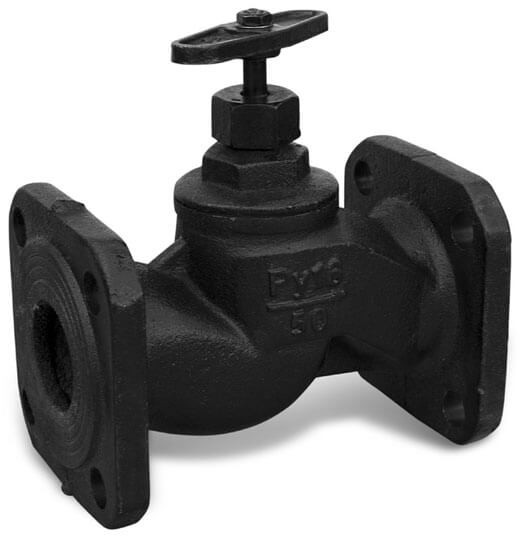

If this parameter is lower, it is recommended to use modern plug valves, such as in the photo, since the valves have serious drawbacks:
- it is necessary to periodically fill the gland, even if the valve is not used, since the packing, in contact with water, gradually collapses;
- after a short period of time, the cheeks begin to overgrow with deposits. If the valve is left unused for several years, it will not be possible to completely close it;
- in case of emergencies, every second can be decisive. If it takes literally a moment to close the plug valve, then it will take a long time to rotate the handle of the valve, even when it is completely serviceable.
It should be noted that cork valves, which are a ball with a water channel surrounded by a plastic sheath, are different:
- practicality;
- durability;
- reliable fluid retention;
- lack of need for maintenance.
Plumbing experts do not recommend purchasing and installing a screw valve on a radiator or the same products of any other type.
They have significant disadvantages of the design solution:
- the gland will need to be filled periodically if there is no desire to put up with a constant leakage along the stem. When it is difficult to replace the valve or fill the gland, then to eliminate the leakage, the valve must be opened to failure with little effort. The leakage will stop due to the fact that the thread on the stem will press the oil seal:
- rubber gaskets for heating elements have a limited shelf life. A valve for a heating radiator with flat brass valves does not hold water after a certain time due to the appearance of deposits on the valve and seat. The same shut-off elements with wedge-shaped brass valves, after closing them with effort, often wedge in the saddle;
- all screw valves are installed only along the water flow. For orientation, a pointer is depicted on the body of many products. The installation of the valve against the water inflow will certainly end with the valve tearing off and then blocking the water tightly.
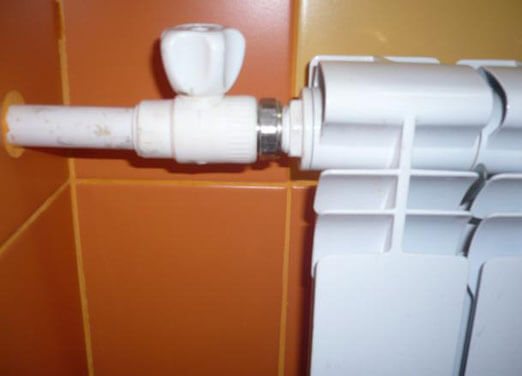

Another undesirable prospect is associated with the operation of the valve - the possibility of water hammer if the valve is not completely closed and turbulence arises in the water flow, periodically closing the seat. Water hammer
- these are short-term pressure surges, as a result of which the weakest parts of the heating circuit are destroyed.
Types of cranes
Reinforcement can be conventionally divided as follows:
- ball half-turn valve;
- balancing valve;
- thermostatic valve;
- flushing valve;
- Mayevsky's bleed-off crane.
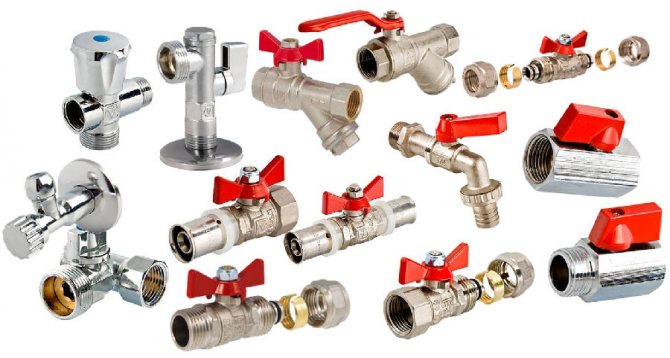

Cranes differ in price, design and application features, which determine where and for what purpose the device is installed.
There are valves with manual and automatic adjustment, here the difference is also noticeable in the price of the valve. The system with automatic temperature control works as follows: the controller receives a signal from the temperature sensor and gives a command to the servo drives, as a result of which the size of the flow hole in the valve is adjusted depending on the set mode.
Note! Manual valves are much cheaper than those equipped with an automatic thermostat.
Ball half-turn valve
The name of the valve is due to the spherical shape of the valve, which has a through hole. The valve is designed for only two positions - open or closed; it is not intended for operation in a quarter of a turn. When you turn the handle of the valve, the valve also rotates, and the hole in it turns out to be located either parallel or perpendicular to the pipeline.
The body of the device is made of steel, brass, bronze or silumin. Steel is the leader in strength, but it is susceptible to corrosion, therefore, bronze and brass products are preferable as they are more durable.
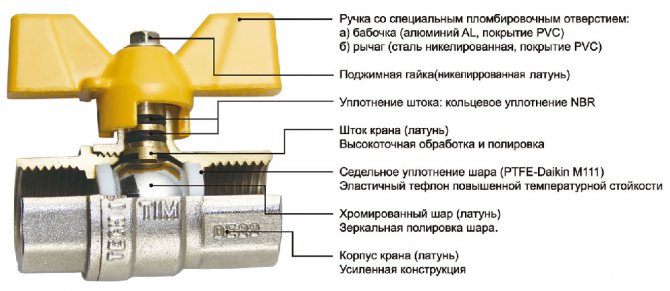

A good choice would be a brass half-turn with thick walls and an American - this is the name of a union nut, which allows you to connect pipes and a radiator without rotating them and quickly.
Note! In a design with a single-pipe riser, it is necessary to provide for the presence of a bypass, and move it away from the main pipe.
Balancing valve
The difference between a balancing valve and a ball valve is the possibility of smooth adjustment of the valve position by several turns of the wing. To prevent the settings of the valve from getting lost, or someone accidentally knocking them down, it can be fixed in its current position. It is placed on the outlet pipe of the battery, and makes it possible to smoothly regulate the flow of the coolant.
Note! It is recommended to install balancing valves on all batteries except the last in the circuit. At the latter, both at the entrance and at the exit, you can put ball half-turns.
Valve with thermostat
The most expensive, but also the best quality, are thermostatic valves. The thermal head is adjusted to a certain room temperature and affects the valve stem.
Under its influence, the valve increases or decreases the cross-section of the hole for the passage of the coolant, due to which the temperature of the radiator is regulated. The installation of a valve with a thermal head is carried out on the inlet pipe, and a balancing valve is placed on the outlet pipe.
Note! To simplify the drainage of the coolant, it makes sense to install a valve equipped with a drain fitting at the outlet of the radiator. The fact is that during flushing, the coolant is drained repeatedly until relatively clean water begins to flow from the battery.
Flush cock
As the name suggests, it is designed to drain water or other coolant from the radiator in order to flush it. It consists of a body made of metal and a long stem, equipped with a rubber gasket. Opens with pliers or wrench. The downside of the design is the rapid wear of the rubber gasket and the need to replace it.
Mayevsky's air cock
On modern radiators, the installation of Mayevsky taps is provided, some models are supplied with already built-in valves. The Mayevsky crane is mounted in the upper part of the battery, since it is at the top that compressed air accumulates.
The valve is operated, as a rule, with a flat screwdriver or a wrench. The air is vented until the hissing stops and water begins to ooze from the tap.
Helpful tips for choosing
Several features are described below in order to determine which products are best to use.
Locking mechanism
Thermostats have two types of locking mechanism: a valve and a valve with a cone (stem). The latter is preferred, it allows for smooth adjustment. The temperature is manually set using a stop ring mechanically. There are also electronic mechanisms, they are more autonomous.
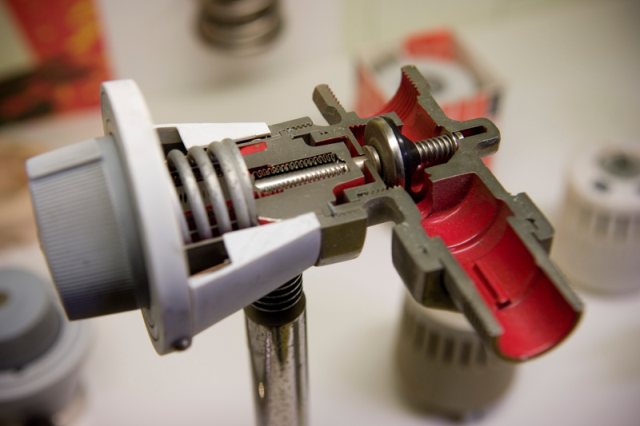

It is better to install ball valves than valves, which have a number of disadvantages: the gland will wear out faster, overgrow with deposits, and close for a long time. Disadvantages of the Mayevsky crane: low permeability, it requires a special key or a screwdriver, which is inconvenient to use. If you accidentally twist its stem, it is very difficult to twist it back, overcoming the pressure of the water. Instead, it is recommended to install a conventional valve or special automatic radiator air vents. The optimal and affordable option if temperature control is required is a faucet with a thermal head.
Housing and connections
It is better to install on batteries not standard ball valves, but full bore. In residential, houses and apartments, such mechanisms with a sleeve connection are used.
It is better to choose faucets for heating radiators with a steel or bronze body, but most often they use brass ones, since they are cheaper. The imitation brass is silumin. It is not worth buying a product made from it, it is a very soft metal. Polymer materials are no less reliable, but they have large dimensions. To replace them, you need to cut a piece of pipe.
Products with polymer rather than rubber gaskets are more durable. Taps for adjusting the coolant on heating radiators exclude the possibility of changing them without draining the water, this can be done with straight-through taps or with an American installed (towards the battery).
Products of the firm Itap (Italy), Danfoss are considered to be of the highest quality. The approximate price range is 700–2000 rubles. In the middle price range, there are products of the Oventrop brand - 550–950 rubles. For a limited budget, Luxor is suitable - 450-800 rubles. Chinese or Turkish stamps.
Types of cranes
Reinforcement can be conventionally divided as follows:
- ball half-turn valve;
- balancing valve;
- thermostatic valve;
- flushing valve;
- Mayevsky's bleed-off crane.
Cranes differ in price, design and application features, which determine where and for what purpose the device is installed.
There are valves with manual and automatic adjustment, here the difference is also noticeable in the price of the valve. The system with automatic temperature control works as follows: the controller receives a signal from the temperature sensor and gives a command to the servo drives, as a result of which the size of the flow hole in the valve is adjusted depending on the set mode.
Note! Manual valves are much cheaper than those equipped with an automatic thermostat.
Ball half-turn valve
The name of the valve is due to the spherical shape of the valve, which has a through hole. The valve is designed for only two positions - open or closed; it is not intended for operation in a quarter of a turn. When you turn the handle of the valve, the valve also rotates, and the hole in it turns out to be located either parallel or perpendicular to the pipeline.
The body of the device is made of steel, brass, bronze or silumin. Steel is the leader in strength, but it is susceptible to corrosion, therefore, bronze and brass products are preferable as they are more durable.
A good choice would be a brass half-turn with thick walls and an American - this is the name of a union nut, which allows you to connect pipes and a radiator without rotating them and quickly.
Note! In a design with a single-pipe riser, it is necessary to provide for the presence of a bypass, and move it away from the main pipe.
Balancing valve
The difference between a balancing valve and a ball valve is the possibility of smooth adjustment of the valve position by several turns of the wing. To prevent the settings of the valve from getting lost, or someone accidentally knocking them down, it can be fixed in its current position. It is placed on the outlet pipe of the battery, and makes it possible to smoothly regulate the flow of the coolant.
Note! It is recommended to install balancing valves on all batteries except the last in the circuit. At the latter, both at the entrance and at the exit, you can put ball half-turns.
Valve with thermostat
The most expensive, but also the best quality, are thermostatic valves. The thermal head is adjusted to a certain room temperature and affects the valve stem.
Under its influence, the valve increases or decreases the cross-section of the hole for the passage of the coolant, due to which the temperature of the radiator is regulated. The installation of a valve with a thermal head is carried out on the inlet pipe, and a balancing valve is placed on the outlet pipe.
Note! To simplify the drainage of the coolant, it makes sense to install a valve equipped with a drain fitting at the outlet of the radiator. The fact is that during flushing, the coolant is drained repeatedly until relatively clean water begins to flow from the battery.
Flush cock
As the name suggests, it is designed to drain water or other coolant from the radiator in order to flush it. It consists of a body made of metal and a long stem, equipped with a rubber gasket. Opens with pliers or wrench. The downside of the design is the rapid wear of the rubber gasket and the need to replace it.
Mayevsky's air cock
On modern radiators, the installation of Mayevsky taps is provided, some models are supplied with already built-in valves. The Mayevsky crane is mounted in the upper part of the battery, since it is at the top that compressed air accumulates.
The valve is operated, as a rule, with a flat screwdriver or a wrench. The air is vented until the hissing stops and water begins to ooze from the tap.
Helpful tips for choosing
Several features are described below in order to determine which products are best to use.
Locking mechanism
Thermostats have two types of locking mechanism: a valve and a valve with a cone (stem). The latter is preferred, it allows for smooth adjustment. The temperature is manually set using a stop ring mechanically. There are also electronic mechanisms, they are more autonomous.
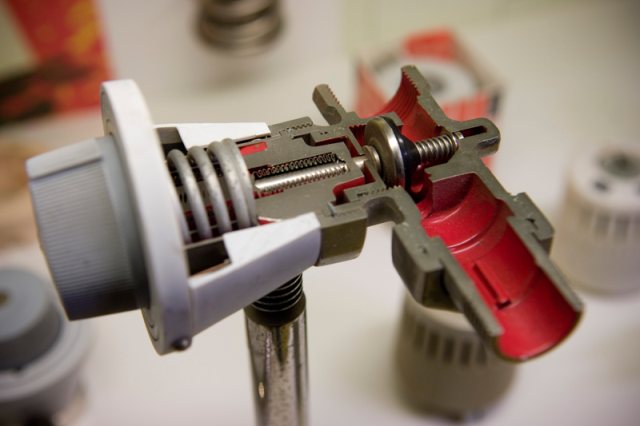

It is better to install ball valves than valves, which have a number of disadvantages: the gland will wear out faster, overgrow with deposits, and close for a long time. Disadvantages of the Mayevsky crane: low permeability, it requires a special key or a screwdriver, which is inconvenient to use. If you accidentally twist its stem, it is very difficult to twist it back, overcoming the pressure of the water. Instead, it is recommended to install a conventional valve or special automatic radiator air vents. The optimal and affordable option if temperature control is required is a faucet with a thermal head.
Housing and connections
It is better to install on batteries not standard ball valves, but full bore. In residential, houses and apartments, such mechanisms with a sleeve connection are used.
It is better to choose faucets for heating radiators with a steel or bronze body, but most often they use brass ones, since they are cheaper. The imitation brass is silumin. It is not worth buying a product made from it, it is a very soft metal. Polymer materials are no less reliable, but they have large dimensions. To replace them, you need to cut a piece of pipe.
Products with polymer rather than rubber gaskets are more durable. Taps for adjusting the coolant on heating radiators exclude the possibility of changing them without draining the water, this can be done with straight-through taps or with an American installed (towards the battery).
Products of the firm Itap (Italy), Danfoss are considered to be of the highest quality. The approximate price range is 700–2000 rubles. In the middle price range, there are products of the Oventrop brand - 550–950 rubles. For a limited budget, Luxor is suitable - 450-800 rubles. Chinese or Turkish stamps.
Types of control valves
Existing modern technologies of heat supply make it possible to install a special tap on each radiator, which controls the quality of heat. This control valve is a shut-off valve heat exchanger that is piped to the radiator.
According to the principle of their work, these cranes are:
Ball, which primarily serve as 100% protection against emergencies. These shut-off devices are a design that can rotate 90 degrees, and can pass water or obstruct the passage of the coolant.
The ball valve must not be left half-open, as this could damage the O-ring and cause leakage.
- Standard, where there is no temperature scale. They are represented by traditional budget valves. They do not give absolute control accuracy. Partially blocking the access of the coolant to the radiator, they change the temperature in the apartment by an undefined value.
- With a thermal head, which allow you to adjust and monitor the parameters of the heating system. Such thermostats are automatic and mechanical.
Conventional direct thermostat
A direct-acting thermostat is a simple device for controlling the temperature in a heating radiator, which is installed near it. By its design, it is a sealed cylinder, into which a siphon with a special liquid or gas is inserted, which clearly responds to changes in the temperature of the coolant.
When it rises, the liquid or gas expands. This leads to an increase in pressure on the stem in the thermostat valve. He, in turn, moving, blocks the flow of the coolant. When the radiator cools down, the reverse process takes place.
Temperature controller with electronic sensor
The principle of operation of this device does not differ from the previous version, the only difference is in the settings. If in a conventional thermostat they are performed manually, then the electronic sensor does not need this.
Here the temperature is set in advance, and the sensor monitors its maintenance within the specified limits. The electronic thermostatic sensor regulates the control parameters of the air temperature in the range from 6 to 26 degrees.
Mayevsky crane
In addition to water taps, air taps are mounted on heating batteries. They are called Mayevsky cranes. They help to remove air that inevitably forms in pipes and radiators during the operation of the system. The installation instructions for heating systems provide for the installation of such devices at the top of each heating panel.
Operating principle
The main element of the Mayevsky tap is a needle air valve. This mechanism can be driven by a special key or a simple screwdriver.
The air valve must be installed on the opposite side of the heating radiator from the inlet valve.As the coolant is poured, the air space in the battery rises up and accumulates in the far upper corner of the device. There, a tap is installed through which the emerging airlock is vented.
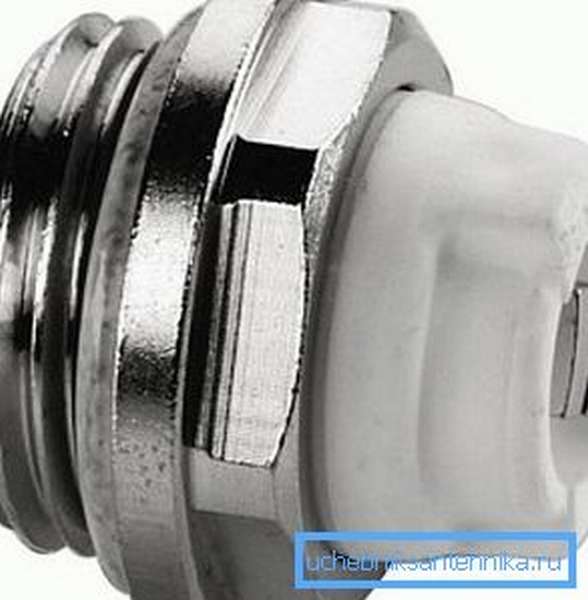

The procedure for working with the Mayevsky valve is simple: it is necessary to unscrew the screw until a hissing sound appears, which is emitted by the emerging air space. When water appears from the intended hole, it is possible to close the valve.
The valve can have a polymer body or be made of bronze. Both of these options are completely reliable. It is only necessary to ensure that the outlet of the air valve is not clogged with hard particles, which from time to time are seen in the coolant. It is possible to clean it with a simple needle.
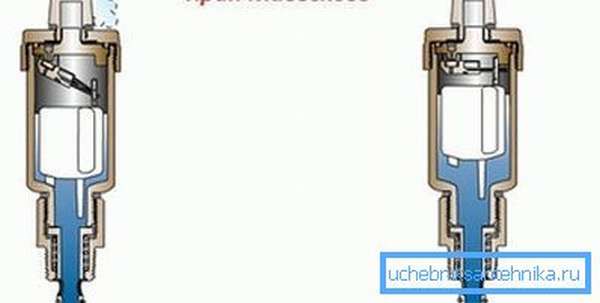

Advice! If your home is equipped with a heating system with forced circulation, then before removing the air lock using the Mayevsky crane, you need to turn off the pumping equipment. Otherwise, warm water will flow too quickly and the air space will not have time to accumulate in the upper part of the radiator.
Automatic air valves
Any manufacturer of plumbing equipment is trying to produce equipment that regulates certain parameters of the operation of engineering networks without human intervention. This also applies to air valves, which remove plugs from radiators and heating pipes.
Mayevsky's involuntary crane from the outside does not actually differ from its progenitor. In addition, the principle of its functioning has not undergone any transformations. But, a special mechanism automatically opens the valve when the air pressure in the battery rises above the set value.
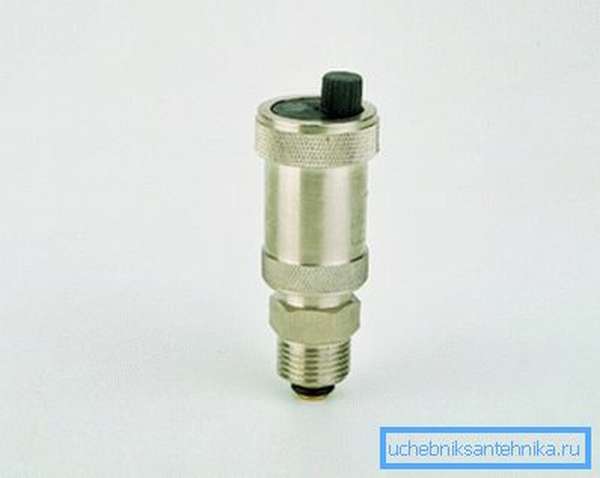

So, the installed involuntary air valve will save you from the need to periodically check the heating system for the detection of air congestion and their manual elimination.
Features of the installation of automatic Mayevsky cranes
This device can be mounted on virtually all existing radiators. But the owners of the widespread cast iron batteries will have to be disappointed. Mayevsky's crane will not help them cope with the air in the climate network.
This is affected by the following events:
- The internal surfaces of a cast-iron radiator during operation are slowly covered with rust, the particles of which come off, enter the coolant and can clog the bypass hole of the automatic air valve.
- The central water supply system, of which cast-iron batteries are part, is not equipped with filters that trap solid particles in the heat transfer fluid. In addition, quite often various aggressive chemicals are added to the water, which, in addition, adversely affect the operation of the air valves.
- Radiators connected to the municipal heating system are often drained during the summer. Based on this, at the end of the filling of the system, too large plugs can appear, which will not be bleed through the 2-mm hole. We'll have to use more effective methods.
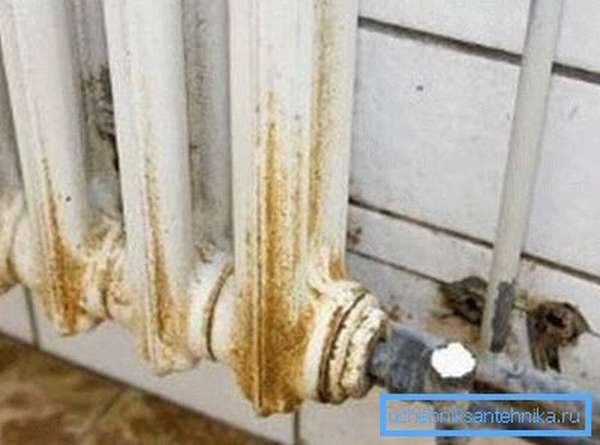

Note! All the advantages of Mayevsky's automatic cranes are revealed only when designing autonomous control systems, where it is possible to control the quality of the coolant, its temperature, pressure and other, no less serious operating parameters.
Features of installation and maintenance of regulators
Thermoregulator installation diagram
After choosing the optimal model of the thermostat or valve for adjusting the heating temperature, you should perform their correct installation. The location of the reinforcement directly depends on its function and design.
Most often, the regulation components are mounted in the piping of a specific heating radiator. They are installed on the supply pipe or on the bypass.At the same time, for comfortable regulation of the temperature of the heating batteries, it is recommended to adhere to the following rules:
- The device should not be covered with decorative panels or other interior items;
- The service life of thermostats largely depends on the quality of the coolant. Therefore, a mesh filter should be installed in front of it, which will protect the valve seat from limescale;
- When installing the heating temperature control valve, follow the installation diagram. On the body of the device, arrows show the direction of movement of the coolant;
- Many thermostats and servos are connected to the mains. Therefore, you need to provide a power supply to them.
Before installing and further adjusting heating batteries in an apartment, you must read the manufacturer's instructions. It prescribes the installation conditions for the operation of a specific control element.
One of the important indicators of apartment heating control valves is the maximum and minimum throughput. They must correspond to the current parameters of the system.

